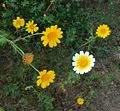- Garland chrysanthemum
-
Garland chrysanthemum
Chrysanthemum coronarium
Chrysanthemum coronarium Scientific classification Kingdom: Plantae (unranked): Angiosperms (unranked): Eudicots (unranked): Asterids Order: Asterales Family: Asteraceae Genus: Chrysanthemum Species: C. coronarium Binomial name Chrysanthemum coronarium
L.Synonyms Glebionis coronaria (Linnaeus) Cassini ex Spach
Chrysanthemum coronarium var. spatiosum L. H. Bailey
Chrysanthemum roxburghii Desf
Chrysanthemum spatiosum (L. H. Bailey) L. H. Bailey
Glebionis roxburghii (Desf.) Tzvelev[1]Garland chrysanthemum, botanically Chrysanthemum coronarium or Leucanthemum coronarium, also known as chrysanthemum greens or edible chrysanthemum, is native to the Mediterranean and East Asia. It is a leaf vegetable in the genus Chrysanthemum, or by some botanists in Leucanthemum.
Contents
Characteristics
A leafy herb, the Garland chrysanthemum, Chrysanthemum coronarium, is one of the few annual plants in its genus and has yellow florets grouped in small rayed flower heads and aromatic, bipinnately lobed leaves. The vegetable grows very well in mild or slightly cold climates, but will go quickly into premature flowering in warm summer conditions. Seeds are sown in early spring and fall.
"The plant is rich in minerals and vitamins with potassium concentrations at 610 mg/100 g and carotene at 3.4 g/100 g in edible portions. In addition, the plant contains various antioxidants (in stem, leaf,and root tissues) that have potential long-term benefits for human health, although toxic (dioxin) properties have also been observed. Extracts from C. coronarium var. spatiosum have been shown to inhibit growth of Lactobacillus casei, a beneficial human intestinal bacterium."[2]
Food uses
 Tần ô being sold in a Los Angeles market.
Tần ô being sold in a Los Angeles market.
It is popular in Korean traditional soups, stews, hot pots, and casseroles, Cantonese cuisine, especially in the cuisine of Hong Kong, and in Japanese cuisine in Nabemono . Overcooking should be avoided and it is recommended to add it at the last moment to hot pot since it easily loses the structure. The leaves are an important ingredient in Taiwanese Oyster omelettes and, when young, are used along with stems to flavor soup and stir-fry.
In Crete, a variety of the species called mantilida (μαντηλίδα) has its tender shoots eaten raw or steamed by the locals. (see Greek cuisine)
Common names
- chop-suey-green
- crown daisy
- garland chrysanthemum
- Japanese-green
- tangho
- tongho
- shungiku
- antimonio
- mirabeles
- moya
- kikuna
- kelsang/kaysang (Tibetan, Wylie transliteration: skal bzang)
- pak thang-o (ຜັກຕັງໂອ)
Gallery
-
In Israel
See also
References
- ^ Germplasm Resources Information Network - (GRIN) Online Database. "Taxon: Glebionis coronaria (L.) Cass. ex Spach". GRIN Taxonomy for Plants. USDA, ARS, National Genetic Resources Program, Beltsville, Maryland. http://www.ars-grin.gov/cgi-bin/npgs/html/taxon.pl?417417. Retrieved 2008-01-10.
- ^ Teixeira da Silva Jaime A., Yonekura Lina, Kaganda Joyceline, Mookdasanit Juta, Nhut Duong T. and Afach Ghanwa (2005) 'Important Secondary Metabolites and Essential Oils of Species Within the Anthemideae(Asteraceae)', Journal of Herbs, Spices & Medicinal Plants, 11: 1, 1 — 4
External links
Categories:- Chrysanthemum
- Flora of East Asia
- Flora of China
- Flora of Korea
- Leaf vegetables
- Cantonese cuisine
- Hong Kong cuisine
- Vietnamese ingredients
Wikimedia Foundation. 2010.




